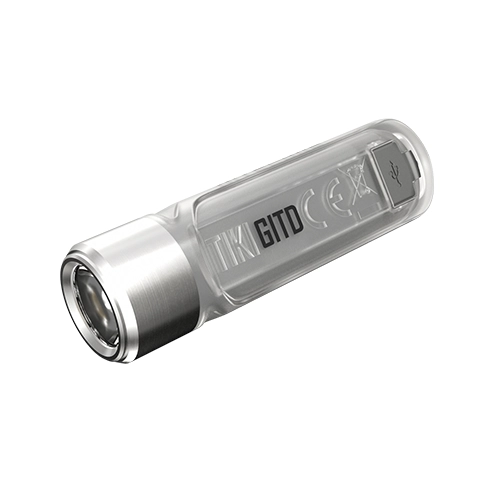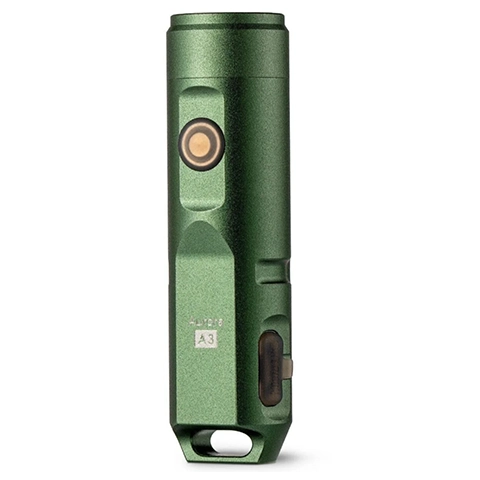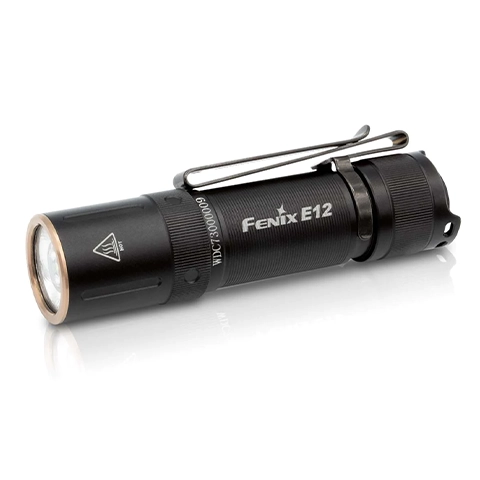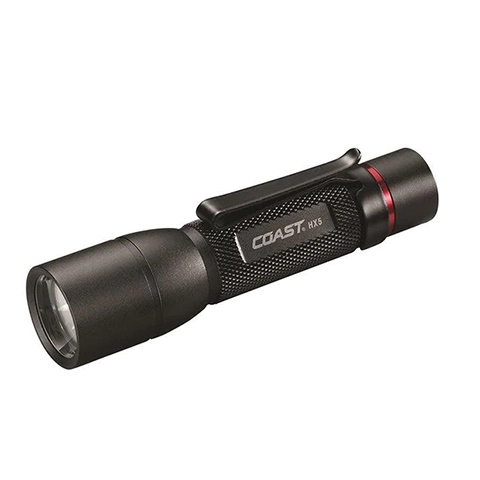

For ultralight hikers and backpackers, base weight is everything. Every additional ounce works against you as your journey progresses.
That’s why your choice of flashlight can make or break an expedition – you need one that’s dependably bright but so lightweight you’ll forget it’s there.
With new high-powered, low-weight options available all the time, selecting the best ultralight hiking flashlight can seem impossible.
This guide cuts through the clutter to focus on exactly what you should look for, and recommend some true trail-tested trailblazers in the lightweight flashlight category. Let’s get started.

Key Specs
Weight: 0.42 ounces (12 grams)
Light Output: 300 lumens
Max Battery Life: 40 hours (lowest setting)
IP Rating: IP66
Price: $$
PROS
✅ Ultralight
✅ Micro-USB rechargeable
CONS
❌ Buttons are very small
The Nitecore TIKI GITD packs a surprising amount of light into a tiny keyring-sized package. Featuring an OSRAM P8 LED capable of 300 lumens, it punches well above its weight class in terms of brightness.
Beyond just standard white light, the TIKI GITD offers some very handy auxiliary lighting options. Dual side LEDs provide extra illumination where you need it, while a high CRI white LED and UV light open up possibilities like checking banknotes or glow-in-the-dark effects.
Where this light really shines is its versatility. With multiple lighting modes and a rechargeable 130mAh battery, it’s ready for a wide range of everyday carry tasks. The integrated micro-USB charging is also a nice touch of modern functionality.
While the tiny buttons and UV glow could be improved, the TIKI GITD delivers impressive performance for its small size. Its bright and customizable light in a keychain form factor makes it a very appealing option. The integrated charging system is safe and simple to use as well.
Overall, this little light proves that big things can indeed come in small packages.

Key Specs
Weight: 1.34 ounces (38 grams)
Light Output: 720 lumens
Max Battery Life: 55 hours (lowest setting)
IP Rating: IP67
Price: $$$
PROS
✅ Reasonably powerful
✅ Micro-USB rechargeable
✅ Great battery life
CONS
❌ No lockout feature
The Nitecore TIP 2 packs an incredible amount of light into a tiny keyring-sized package. Utilizing dual Cree XP-G3 LEDs, it is capable of an impressive 720 lumens maximum output.
What’s particularly impressive is how quickly it can be recharged thanks to the integrated micro-USB port. Charging status is clearly displayed as well. With four brightness levels and useful daily/demo modes, the TIP 2 adapts to any situation.
Despite its miniature dimensions, thermal performance is on point. An aluminum alloy body ensures heat dissipation is efficient. Runtimes remain strong even at high lumen outputs.
While the small control buttons and lack of lockout take some adjustment, overall the TIP 2 showcases Nitecore’s unparalleled expertise in compact, high-powered illumination.
With incredible brightness from such a small form factor and swift USB recharging, the TIP 2 is a testament to Nitecore’s ability to pack big performance into a tiny package. It remains a superior choice for a keychain EDC light.

Key Specs
Weight: 0.69 ounces (19.5 grams)
Light Output: 650 lumens
Max Battery Life: 30 hours (lowest setting)
IP Rating: IP66
Price: $$
PROS
✅ Reasonably powerful
✅ Micro-USB rechargeable
✅ Emergency strobe feature
CONS
❌ Can lose charge after sitting
The RovyVon A3X proves that high performance lighting doesn’t require a bulky package. Boasting an impressive 650 lumen output from its LED, it provides ample brightness despite its pocket-sized dimensions.
A key upgrade over previous RovyVon lights is the new side e-switch interface. Gone is the twisty operation, replaced with easy one-button access to multiple output modes. Quick selection of daily use modes and emergency strobe make it versatile for any scenario.
Convenient micro-USB recharging keeps it powered up and ready for action. Its anodized aluminum construction feels tough enough for backcountry use too.
Admittedly, battery life when not in use could be better—a full month of sitting and it may no longer hold a charge. However, given its miniature stature, some battery drain is acceptable.
Overall the RovyVon A3X proves size isn’t everything. Its feat of compactness and high lumen performance earn it a place as a go-to trail companion any ultralight hiker or backpacker will appreciate.

Key Specs
Weight: 1.80 ounces (51 grams)
Light Output: 160 lumens
Max Battery Life: 70 hours (lowest setting)
IP Rating: IP68
Price: $$
PROS
✅ All-metal construction
✅ Can be used with rechargeable batteries
CONS
❌ Modest brightness modes
The Fenix E12 V2.0 proves that an everyday carry flashlight doesn’t need bulky batteries or complex interfaces to be effective. Powered by a single ubiquitous AA battery, it provides a maximum output of 160 lumens that’s ample for most tasks.
Its compact size and smooth reflector produce a well-balanced beam that easily adapts to various indoor and outdoor situations. Simple brightness adjustment via the side e-switch also adds convenience.
A versatile two-position pocket clip further improves portability. It carries comfortably and is always ready when needed.
Admittedly, the lowest 5-lumen setting could stand to be a bit brighter for close-up use. 10-15 lumens would be preferable here.
However, this is a minor nitpick of an otherwise well-designed light. The Fenix E12 V2.0 delivers foolproof performance thanks to its durable build quality and use of standard AA power. It proves inexpensive lights can still be practical workhorses.
While not for every user, the E12 V2.0 shows why Fenix remains a leader in lighting powered by common battery formats.

Key Specs
Weight: 2.78 ounces (79 grams)
Light Output: 180 lumens
Max Battery Life: 3.75 hours
IP Rating: IP54
Price: $
PROS
✅ Extremely affordable
✅ Can be used with rechargeable batteries
CONS
❌ On/off button reliability
❌ One brightness mode
The Coast HX5 stands out thanks to its unique hands-free magnetic design, perfect for tasks where both hands are needed. Switching between a tight spot beam and wide flood is easy via its dual LED setup.
Versatile performance is further improved through the use of common AA batteries. While top brightness requires high-drain cells, overall runtime and flexibility are excellent considering the size.
Hard to argue with the value offered by its competitive price tag too. For basic lighting needs, the HX5 certainly delivers.
Admittedly, reliability concerns were noticed with the on/off switch over repeated use. A potential durability issue to be aware of long term.
However, this alone doesn’t negate what is still an excellent overall performer for its affordable cost. Considering the included battery compatibility and hands-free magnetic base, the HX5 remains a strong budget choice for simple tasks around the house or campsite.
Here are some recommendations for how to choose the best hiking flashlight:
And if you’re trying to decide between a hiking flashlight or a headlamp, you can explore our detailed post here for additional insights and guidance.
Look for a flashlight that is waterproof, as you may end up using it in wet conditions like rain. A waterproof design ensures the flashlight will keep working even if it gets submerged in water. Durability is also important – the flashlight should be built with durable materials and have a long-lasting battery that won’t leave you in the dark. An adjustable lighting feature is very useful, as you may need a bright light sometimes and a dimmer light at other times depending on the situation. Adjustable lighting allows you to switch between light levels as needed for the trail conditions. Lightweight design is another plus, especially for long hikes, as no one wants to lug around an unnecessarily heavy flashlight. Overall, waterproofing, long battery life, adjustable lights, and a lightweight design are great qualities to have in a dependable hiking flashlight.
The average lifespan of a typical hiking flashlight is around 2-3 years with regular use. Quality flashlights from reputable brands like Fenix, Nitecore, and Coast that utilize durable materials and well-designed electronic components tend to last longer than no-name or cheaper options. Proper care like replacing batteries regularly, avoiding very high or low temperatures, keeping O-rings and seals lubricated, and not dropping the light can help maximize its lifespan. However, even the toughest lights will eventually show wear over years of heavy use in the outdoors.
The beam distance of a typical hiking flashlight can range greatly depending on the brightness level and type of bulb or LED, but on high power most quality models should illuminate targets out to at least 100 yards or further, with very bright flashlights able to reach 200 yards or more. Brighter flashlights tend to work best for long range signaling or viewing faraway terrain at night on the trail, while lower settings preserve battery life for general close-up use.
If weight is no issue, some of the top-rated flashlights for backpacking, camping, trekking, and night hiking gear include Fenix, Nitecore, and Surefire models. The Fenix PD36R and PD32 V2.0 are popular for their compact size, up to 1000-lumen brightness, and included rechargeable batteries. Nitecore flashlights such as the P36 and P30 offer durable aluminum constructions and powerful beams to light trails at night. Meanwhile, Surefire flashlights like the G2X and E2D provide reliable illumination for camping and trekking adventures thanks to their rugged build and long-lasting included batteries. In general, the best backpacking flashlights provide long battery life, durable water-resistant construction, and bright focused beams for safely navigating trails after dark – making them invaluable accessories for outdoor activities.